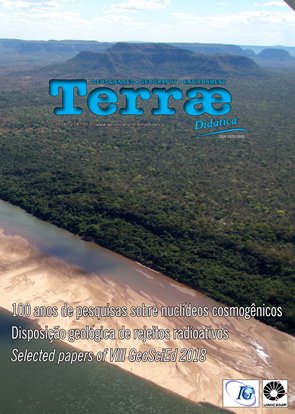Resumo
The origins, uses and fates of a number of purpose built urban educational resources sited in the north of England are reviewed. These include walk on geological maps, building stone trails, a church gate and landscaping in a city park. A geological trail in the municipal cemetery of Rochdale dating from 1855 is a candidate for the oldest purpose made geological education trail in the world and the most recent educational resource was built in 2015. The destruction of a walk on geological map of England and Wales in 2004 shows that such valuable geoscience educational resources are in need of protection. A range of educational uses of these resources are suggested. Comparison is made with similar resources in London, both statuary and web based, and ways to ensure their preservation and continued educational use are suggested. This study shows that a geoscience education resource, if sited in the right place and looked after, can be an exciting and inspirational education resource in regular use for over half a century.Referências
Baldwin A., Anderson D.M. 1996. A remarkable survivor: a nineteenth century geological trail in Rochdale, England. The Geological Curator, 6:227-232.
Brears P. 1989. Of curiosities and rare things. The story of Leeds City museum. Friends of Leeds City Museum.
Burek C., Hope M. 2006. The use of town trails in raising awareness of urban geodiversity. International Association for Engineering Geology (IAEG) congress 2006 paper no. 609. Geol. Soc. London. 7pp.
Dimes F.G., Mitchell M. 1996. The building stone heritage of Leeds. The Leeds Philosophical and Literary Society.
Dimes F.G., Mitchell M. 2006. The building stone heritage of Leeds. 2nd ed. The Leeds Philosophical and Literary Society.
Hanibal J.T. 2007. Teaching with tombstones: geology at the cemetery. In: Shaffer N.R., DeChurch D.A. eds. Proceedings of the 40th forum on the geology of industrial minerals, May 2-7, 2004, Bloomington, Indiana: Indiana Geol. Survey Occasional paper, 67:82-88
Kabrna P. 2007. John Milne: the man who mapped the shaking Earth. Craven and Pendle Geological Society
Kennet P. 2017. Primary Matters - fun with geology in primary schools. Teaching Earth Sciences 42(2):55-58
Mitchell M. 2002. The memorial lychgate at St Marys Church, Whitkirk, Leeds. Proceedings of the Yorkshire Geological Society 54(2):121-124
Murphy P.J., Evans R. 2014. Building Stone Trails: a new look at an old friend. Teaching Earth Sciences, 39(2):29-32.
Murphy P.J., Murphy E. 2002. Urban Geological Trails: A tool for teaching key stage three Earth Sciences. School Science Review, 83(305):140-143.
Murphy P J. 2017. A tale (in stone) of four cities. Teaching Earth Sciences, 42(2):38-40.
Randles A. 2017. Rock around Campus. Teaching Earth Sciences, 42(2):53.
Robinson E. 1984. London illustrated geological walks. Scottish Academic Press. Robinson E. 1985. London illustrated geological walks book 2. Scottish Acad. Press.
Simpson I., Broadhurst F. 1975. A Building Stones Guide to Central Manchester. Dept. Extra Mural Studies, Univ. Manchester.
Simpson M. & Broadhusrt F.A. (Revised: Strother P., Rhodes J). 2014. A building stones guide to Central Manchester (third edition). Manchester Geol. Assoc.
Versey H C. 1940. Ornamental stones of Leeds. Trans. Leeds Geol. Assoc., 5(5):297-300.
Winchester S. 2001. The map that changed the world. Penguin Books.
http://www.earthlearningidea.com/PDF/135_ Gravestones.pdf
http://www.englishstone.org.uk/Biblio_c.html
http://rochdale-past.co.uk/geological-stone-pillars/
http://www.rochdale.gov.uk/pdf/463%20-%20Pioneers’%20graves%20booklet.pdf
https://www.bradford.gov.uk/media/2272/manningham09listerpark.pdf
https://historicengland.org.uk/listing/the-list/ list-entry/1001222
http://www.cpgs.org.uk/ [8] http://www.ingletonwaterfallstrail.co.uk/
https://www.yorkmuseumgardens.org.uk/the-mosaic-map/
http://londonpavementgeology.co.uk/
http://www.ucl.ac.uk/~ucfbrxs/Homepage/UrbanGeology.htm
https://www.visitlondon.com/things-to-do/ place/198408-crystal-palace-park#rilHg0YODpCg541s.97
A Terrae Didatica utiliza a licença do Creative Commons (CC), preservando assim, a integridade dos artigos em ambiente de acesso aberto, em que:
- A publicação se reserva o direito de efetuar, nos originais, alterações de ordem normativa, ortográfica e gramatical, com vistas a manter o padrão culto da língua, respeitando, porém, o estilo dos autores;
- Os originais não serão devolvidos aos autores;
- Os autores mantêm os direitos totais sobre seus trabalhos publicados na Terrae Didatica, ficando sua reimpressão total ou parcial, depósito ou republicação sujeita à indicação de primeira publicação na revista, por meio da licença CC-BY;
- Deve ser consignada a fonte de publicação original;
- As opiniões emitidas pelos autores dos artigos são de sua exclusiva responsabilidade.

